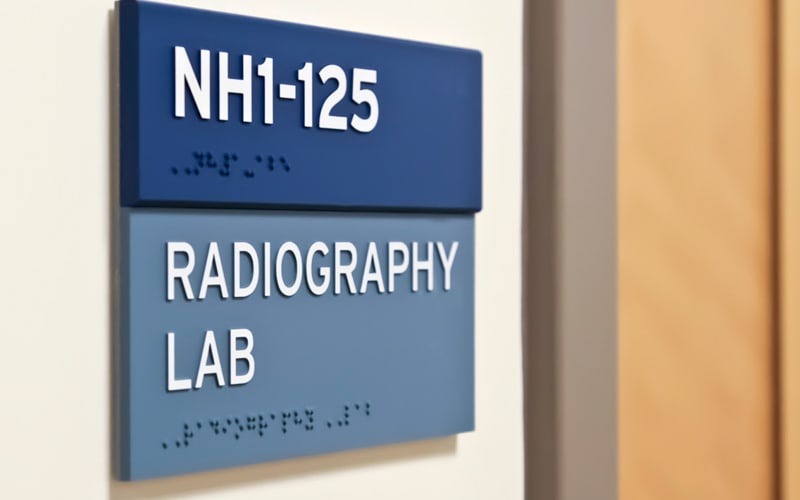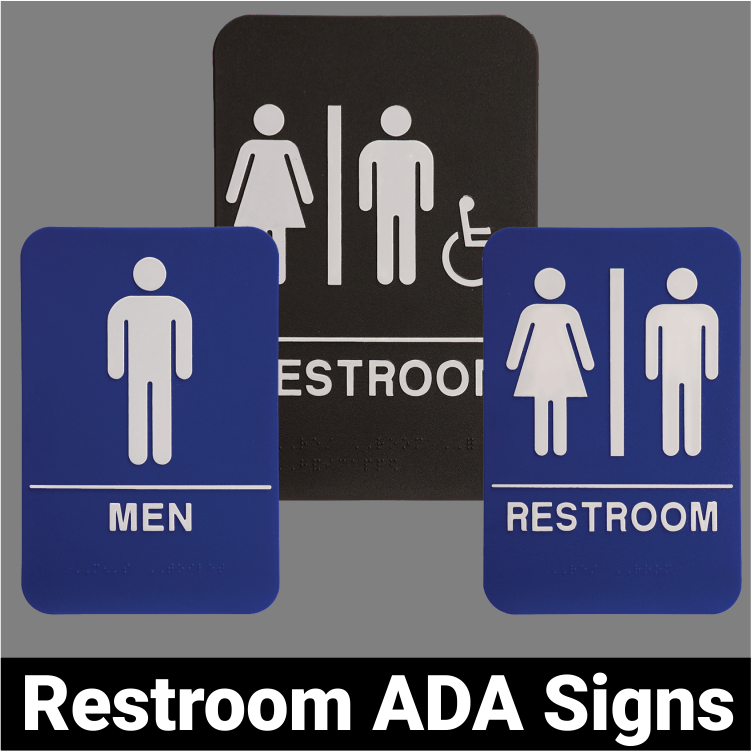Discover the Relevance of ADA Signs in Public Spaces
Discovering the Trick Attributes of ADA Indicators for Boosted Accessibility
In the world of access, ADA indications offer as silent yet effective allies, guaranteeing that areas are navigable and comprehensive for people with impairments. By incorporating Braille and tactile components, these indications break obstacles for the visually impaired, while high-contrast shade plans and readable typefaces cater to diverse aesthetic demands.
Value of ADA Conformity
Guaranteeing conformity with the Americans with Disabilities Act (ADA) is critical for fostering inclusivity and equal accessibility in public spaces and work environments. The ADA, established in 1990, mandates that all public centers, employers, and transportation solutions suit people with impairments, guaranteeing they appreciate the same legal rights and possibilities as others. Conformity with ADA standards not only satisfies lawful commitments but likewise improves a company's credibility by demonstrating its dedication to diversity and inclusivity.
One of the vital facets of ADA compliance is the implementation of available signage. ADA indications are made to make certain that people with disabilities can easily navigate through buildings and areas. These indications should follow certain guidelines concerning size, font style, color contrast, and placement to guarantee presence and readability for all. Properly executed ADA signage assists get rid of obstacles that individuals with disabilities commonly encounter, consequently advertising their self-reliance and self-confidence (ADA Signs).
Moreover, adhering to ADA regulations can reduce the risk of legal repercussions and possible penalties. Organizations that fall short to conform with ADA guidelines might face penalties or legal actions, which can be both damaging and monetarily troublesome to their public photo. Therefore, ADA conformity is important to fostering an equitable environment for everybody.
Braille and Tactile Components
The unification of Braille and tactile components into ADA signs embodies the principles of accessibility and inclusivity. These functions are essential for people who are blind or aesthetically impaired, allowing them to navigate public areas with better self-reliance and self-confidence. Braille, a tactile writing system, is necessary in providing composed info in a layout that can be easily viewed via touch. It is generally put under the corresponding text on signs to ensure that individuals can access the information without aesthetic assistance.
Tactile aspects prolong beyond Braille and include raised characters and icons. These parts are created to be discernible by touch, enabling individuals to determine space numbers, washrooms, exits, and various other important locations. The ADA sets specific standards pertaining to the dimension, spacing, and placement of these tactile components to maximize readability and make sure consistency throughout various atmospheres.

High-Contrast Color Pattern
High-contrast color design play an essential role in improving the visibility and readability of ADA signs for individuals with visual impairments. These schemes are crucial as they optimize the distinction in light reflectance between text and history, making sure that signs are conveniently discernible, also from a distance. The Americans with Disabilities Act (ADA) mandates the usage of particular shade contrasts to accommodate those with minimal vision, making it a vital aspect of conformity.
The efficacy of high-contrast colors depends on their ability to attract attention in various lights conditions, including poorly lit environments and areas with glow. Generally, dark message on a light background or light message on a dark history is utilized to attain ideal contrast. For circumstances, black text on a yellow or white history gives a stark visual distinction that aids in quick recognition and understanding.

Legible Fonts and Text Dimension
When considering the style of ADA signs, the selection of understandable fonts and suitable text size can not be overstated. These aspects are critical for guaranteeing that indications are easily accessible to people with aesthetic problems. The Americans with Disabilities Act (ADA) mandates that typefaces should be not italic and sans-serif, oblique, manuscript, extremely attractive, or of uncommon type. These demands assist make sure that the text is quickly understandable from a distance and that the characters are distinct to varied target markets.
According to ADA guidelines, the minimum text height must be 5/8 inch, and it should boost proportionally with seeing distance. Uniformity in text dimension adds to a natural visual experience, assisting people in navigating environments successfully.
Moreover, spacing between lines and letters is essential to legibility. Ample spacing stops characters from appearing crowded, improving readability. By sticking to these criteria, designers can considerably boost availability, ensuring that signage offers why not find out more its intended function for all people, no matter their aesthetic capabilities.
Efficient Positioning Techniques
Strategic positioning of ADA signs is crucial for making the most of availability and this link making certain compliance with lawful criteria. ADA guidelines stipulate that indicators need to be placed at an elevation between 48 to 60 inches from the ground to ensure they are within the line of view for both standing and seated people.
Furthermore, indications should be put adjacent to the lock side of doors to permit simple identification prior to entrance. This placement assists people situate spaces and spaces without blockage. In situations where there is no door, signs need to be positioned on the closest adjacent wall surface. Consistency in sign positioning throughout a facility boosts predictability, lowering confusion and improving general user experience.

Final Thought
ADA indicators play a vital role in advertising accessibility by incorporating attributes that resolve the demands of people with handicaps. These components jointly promote an inclusive atmosphere, underscoring the importance of ADA compliance in making certain equivalent accessibility for all.
In the world of availability, ADA indications serve as quiet yet effective allies, making sure that areas are navigable and inclusive for individuals with disabilities. The ADA, enacted in 1990, mandates that all public centers, employers, and transportation solutions suit individuals with disabilities, guaranteeing they take pleasure in the exact same rights and possibilities as others. ADA Signs. ADA signs are created to make sure that individuals with handicaps can quickly navigate via areas and structures. ADA standards stipulate that indicators need to be installed at a height in between 48 to 60 inches from the ground to ensure they are within the line of view for both standing and seated individuals.ADA indicators play a crucial role in advertising ease of access by incorporating functions that address the demands of individuals with handicaps